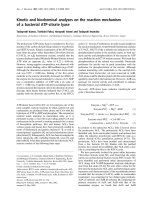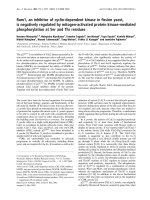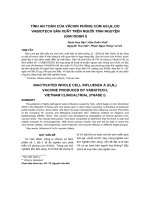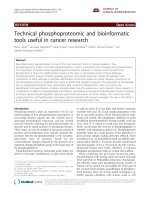Báo cáo y học: "Establishing an EU-China consortium on traditional Chinese medicine research" pot
Bạn đang xem bản rút gọn của tài liệu. Xem và tải ngay bản đầy đủ của tài liệu tại đây (255.86 KB, 6 trang )
EDITOR I A L Open Access
Establishing an EU-China consortium on
traditional Chinese medicine research
Halil Uzuner
1*
, Tai-Ping Fan
2
, Alberto Dias
3
, De-an Guo
4
, Hani S El-Nezami
5
, Qihe Xu
1
Abstract
Traditional Chinese medicine (TCM) is widely used in the European Union (EU) and attracts intense research
interests from European scientists. As an emerging area in Europe, TCM research requires collaboration and
coordination of actions. Good Practice in Traditional Chinese Medicine Research in the Post-genomic Era, also
known as GP-TCM, is the first ever EU-funded 7
th
Framework Programme (FP7) coordination action, aiming to
inform the best practice and harmonise research on the safety and efficacy of TCM through interdisciplinary
exchange of exper ience and expertise among clinicians and scientists. With its increasingly large pool of expertise
across 19 countries including 13 EU member states, Australia, Canada, China, Norway, Thailand and the USA, the
consortium provides forums and collaboration platforms on quality control, extracti on technology, component
analysis, toxicology, pharmacology and regulatory issues of Chinese herbal medicine (CHM), as well as on
acupuncture studies, with a particular emphasis on the application of a functional genomics approach. The project
officially started in May 2009 and by the time of its conclusion in April 2012 a Europe-based academic society
dedicated to TCM research will be founded to carry on the mission of GP-TCM.
Introduction
Traditional Chinese medicine (TCM), especially Chinese
herbal medicine (CHM) and acupuncture, i s an ancient
medical system used in China and other Asian countries
for thousands of years [1,2]. In contrast to the reduc-
tionist approach of Western medicine base d on modern
anatomy, physiology, pathology, pharmacology as well as
cell and molecular biology, TCM uses a unique system
and an individualised and h olistic approach to describe
health and disease, based on the philosophy of Yin-Yang
balance and an emphasis on harmony of functions.
These two medical systems differ greatly in many
respects. In the past seven years, a number of interna-
tional organisations were established in mainland China,
Hong Kong and Macao, including the World Federation
of Chinese Medicine Societies (WFCMS, September
2003), the Consortium for Globalisation of Chinese
Medicine (CGCM, December 2003) and the Interna-
tional Society for Chinese Medicine (ISCM, 2004).
The Good Practice in Traditional Chinese Medicine
Research in the Post-genomic Era (GP-TCM) consor-
tium was launched by the European Commission on the
1
st
May 2009. This is a three-year coordination action
project funded under the EU Seventh Framework Pro-
gramme (FP7) with a total budget of €995,100. The cen-
tral hypothesis of the consortium is that, using
functional genomics technology, which allows high-
content observations of whole profiles of molecules at
different levels, eg DNA, mRNA, protein and metabo-
lites, and furthermore linking them to clinica lly relevant
biological functions, we might be in a better position
than ever before to interpret and validate the scientific
value of TCM in a holistic and functi on-oriented man-
ner [3-11].
Objectives
Focusing on research of CHM and acupuncture, we
especially emphasise studies of CHMs, their complex
chemical ingredients and their holistic impact on the
functional genomics of patients. The overall aim of the
consortium is to inform the best practice and harmonise
research on the safety and efficacy of TCM using a
functional genomics approach through exchange of opi-
nions, experience and expertise among scientists in EU
member states, China and other parts of the world. Spe-
cifically, we aim to undertake the following objectives:
* Correspondence:
1
Department of Renal Medicine, King’s College London, London, UK
Full list of author information is available at the end of the article
Uzuner et al. Chinese Medicine 2010, 5:42
/>© 2010 Uzuner et al; licensee BioMed Centr al Ltd. This is an Open Access article distributed under the terms of the Creative Commons
Attribu tion License ( which permits unrestricted use, distribution, and reproduction in
any medium, provided the original work is properly cited.
• Develop a European-Chinese network, collaborat-
ing on functional genomics research of TCM;
• Review current practice of TCM research, identify
problems and propose solutions;
• Propose standard protocols of methodology;
• Propose priority areas for future research;
• Develop online resources to support and enhance
pan-European studies of TCM research;
• Facilitate and foster a sustainable European colla-
boration by founding a European society dedicated
to TCM research.
Structure
AsshowninFigure1throughtenworkinggroups
known as work packages (WPs), the consortium takes
actions to review the techniques, identify problems and
solutions in the quality control (WP1), extraction and
analysis (WP2) of CHMs. While these fundamental
issu es are addressed, discussion forums emphasising the
use of functional genomics methodology in research of
the safety, efficacy and mechanisms of CHMs (WP3-
WP7) and acupuncture (WP8) form the core of this
coordination project. The project covers toxicology
(WP3), in vitro and in viv o pharmacology (WP4-WP5),
clinical studies (WP6), as well as international regulatory
issues of CHM (WP7). WP9 is dedicated to organising
the Final Conference of the consortium at the end of
the project and WP10 is charged to manage consor-
tium-wide matters, such as appointment and coordina-
tion of WP leadership, recruitment of additional experts,
editing website and newsletters, drafting standard oper-
ating procedures, providing scientific and technological
support and guidance, organising internal review and
quality assurance, as well as liaising with the Commis-
sion and other stakeholders and external authorities.
Membership
As shown in Table 1 the consortium has 27 beneficiary
(ie funded) partner organisations across ten EU member
states (ie Austria, Belgium, Estonia, Germany, Ireland,
Italy, the Netherlands, Portugal, Spain and the UK) and
China, which is an International Cooperation Partner
Country (ICPC) of the EU. The consortium has addi-
tional 60 non-beneficiary (ie unfunded) collaborating
partner organisations as well as two independent experts
from Australia, Austria, Belgium, China, Denmark, Fin-
land,Germany,Italy,Luxembourg,theNetherlands,
Norway, Thailand, the UK and the USA (Table 2).
Please refer to the project website at -tcm.
org/about/partners/ for an updated list of consortium
partners. This forms a diverse, multicultural and multi-
disciplinary team of about 150 principal investigators,
including leading scientists, clinicians, TCM practi-
tioners, as well as experts in industrial developm ent and
regulatory issues. Non-beneficiary membership is mainly
based on consortium invitation and requires outstanding
expertise needed for the project. Interested parties are
welcome to contact us via the GP-TCM website http://
www.gp-tcm.org/contact/. GP-TCM currently covers
half of the 27 EU member states and its members in
China are largely in major eastern and southern cities.
As an open-ended consortium, GP-TCM welcomes
interest ed parties from all EU member states and China
to join our network, sharing resources and forging colla-
borations. We will continue to develop and strengthen
collaborations with friends in Africa, South America,
Asia and non-EU European countries to exchange
experience and lessons learnt in the research of tradi-
tional medicines.
Progress and difficulties
During the first 18 months of the project (May 2009-
-October 2010), the m anagement team (WP10) has coordi-
nated a highly successful team build-up and re-construction.
With the ever-strengthening expertise pool, WP10 has
developed a numbe r of committees and panels that lead t he
consortium with clear d ivisions of labour. WP10 has led the
design and updates of the professi onal GP-TCM website
and all WPs have established their homepages and online
Figure 1 Structure of the GP-TCM Consortium.GP-TCMwork
package interaction and relationship: GP-TCM has ten interactive
working groups, known as work packages (WP). WP1-WP7
specialises in quality control, component extraction and chemical
analysis, toxicology, in vitro and in vivo pharmacology, clinical
studies and regulatory issues in commercial R&D respectively. WP8
is specialised in acupuncture studies and WP9 is dedicated to
organising the Final conference of the consortium, at which a new
European society will be launched to succeed the mission of the
consortium. WP10 is the managing, coordinating and leading body
of the whole consortium, aiming at integrating the expertise and
collating outputs of all WPs to achieve the overall objectives of the
consortium.
Uzuner et al. Chinese Medicine 2010, 5:42
/>Page 2 of 6
discussion faci lities. Periodic newsletters have enabled mem-
bers to share information and stay a s a united team. S ignif i-
cantly, a series of face-to- face meetings, including
consortium and WP kick-off meetings and the 1
st
Annual
General Meeting, have been organised to monitor the con-
sortium, promote i nteractions an d collaborations a nd ensure
milestones are met and deliverables accomplished on time
and in high q ua lity.
Noteworthy WP-specific achievements are as follows.
WP1 led the creation of a list of nearly 300 species of
plants and fungi commonly used in TCM in Europe and
China and a priority list of 11 species will be used by all
WPs in their initial literature analysis. WP 2 worked
jointly with WP1, linking quality control, extraction
technolo gy and chemi cal analysis, with special emphasis
on the importan t role of paozhi (proces sing) in the pro-
duction of CHM. WP3 produced a list of toxic plants
for further literature study and identified 3 major fields
of action: (i) investigation o f methods (classical and
functional genomics) applicable to toxicity evaluation;
(ii) study of toxicological reports avail able on a series of
CHM; (iii) review of pharmacovigilance safety data.
WP4 established evaluation criteria for scoring scientific
articles and began the creation of an appropriate data-
base of literature encompassing functional genomic
applications in CHM research. WP5 performed reviews
on CHM literature involving animal models, especially
models of cancer and its conclusions have laid a solid
foundation for further literature analysis on application
of functional genomi cs in CHM research and proposing
good practice in animal stud ies of CHM. WP6 gathered
literature on seminal studies in clinical CHM studies
and drafted a guideline on clinical trials of CHM. WP6
and WP8 collaboratively designed an online survey tar-
geting TCM practitioners and the survey is currently
undergoing in collaboration with 30 professional acu-
puncture and TCM organisations. WP7 brought
together wide-ranging experiences and expertise in drug
development and registration from Europe, China, Aus-
tralia and North America to discuss the l egislative and
regulatory issues relevant to CHM. Together they are
developing a comprehensive document providing com-
parisons of different practices on CHM regulations and
this will be extremely helpful for the EU to develop its
Table 1 GP-TCM beneficiary members
GP-TCM beneficiary partners Country Contact
King’s College London UK Dr. Qihe Xu
University of Vienna Austria Prof. Verena M. Dirsch
L’Université Libre de Bruxelles Belgium Prof. Pierre Duez
Beijing University of Chinese Medicine China Prof Yanjiang Qiao
China Capital Medical University China Prof. Xiaomin Wang
Institute of Medicinal Plant Development China Prof. Xinmin Liu
Shanghai Institute of Acupuncture-Moxibustion China Prof. Huangan Wu
Shanghai University of Traditional Chinese Medicine China Dr. Liu Chenghai
University of Hong Kong China Dr. Hani El-Nezami
Asper Biotech Ltd Estonia Ms. Janne Üksti
Federal Institute for Drugs and Medical Devices Germany Dr. Werner Knöss
University of Düsseldorf Germany Prof. Peter Proksch
University of Munich Germany Prof. Angelika Vollmar
University of Bonn Germany Prof. Gabriele König
Trinity College Dublin Ireland Dr. Helen Sheridan
University of Milan Italy Prof. Enrica Bosisio
University of Padova Italy Prof. Maria Carrara
CMC Tasly Group BV The Netherlands Dr. You-Ping Zhu
Leiden University The Netherlands Prof. Robert Verpoorte
University of Minho Portugal Prof. Alberto Dias
University of Alcala Spain Prof. F. Javier de Lucio Cazaña
University Hospital Ramón y Cajal-FIBIO Spain Dr. M. Laura García Bermejo
Acu-herb Consultant, Sheffield UK Ms. Dan Jiang
University of Wolverhampton UK Prof. Kelvin Chan
Royal Botanic Gardens, Kew UK Prof. Monique Simmonds
University of Southampton UK Prof. George Lewith
University of Cambridge UK Dr. Tai-Ping Fan
Uzuner et al. Chinese Medicine 2010, 5:42
/>Page 3 of 6
Table 2 GP-TCM non-beneficiary members
GP-TCM Non-beneficiary partners Country Contact
University of Western Sydney Australia Prof. Alan Bensoussan
University of Graz Austria Prof. Rudolf Bauer
University of Mons Belgium Prof. Jean-Marie Colet
Beijing East Linden Science and Technology Co. Ltd. China Prof. Yanhuai Liu
China Academy of Chinese Medical Sciences China Prof. Aiping Lu
China-Japan Friendship Hospital China Prof. Ping Li
Dalian Institute of Chemical Physics China Prof. Xinmiao Liang
Hong Kong Baptist University China Prof. Zhongzhen Zhao
Hong Kong Buddhist Hospital China Prof. Vivian Wong
Jinan University China Prof. Xinsheng Yao
Peking University China Prof. Wenhan Lin
PuraPharm China Mr. Abraham Chan
Shanghai Innovation Research Centre of Traditional Medicine China Prof. William Weiguo Jia
Shanghai Jiaotong University China Prof. Liping Zhao
Shanghai Institute of Materia Medica, Chinese Academy of Sciences China Prof. De-an Guo
Tongji University China Prof. Gang Pei
Tasly Institute of Tasly Group Co., Ltd. China Ms. Karolina J. Svedlund
Tianjin University of Traditional Chinese Medicine China Prof. Boli Zhang
University of Macau China Prof. Yi-Tao Wang
The Chinese University of Hong Kong China Prof. Ge Lin
Pfizer Corporation Hong Kong Ltd China Mr. Stephen Leung
State Food and Drug Administration China Prof. Zhong-zhi Qian
National Research Institute of Chinese Medicine, Taiwan China Prof. Yi-Tsau Huang
University of Aarhus Denmark Prof. Brian Clark
University of Oulu Finland Prof. Olavi Pelkonen
Public Research Centre of Health Luxembourg Dr. Ning Wang
Charité University Medical Center Germany Prof. Claudia M. Witt
Johannes Gutenberg University Germany Dr. Huige Li
University of Regensburg Germany Prof. Gerhard Franz
Philipps - Universität Marburg Germany Prof. Shuming Li
Max Planck Institute for Biophysics Germany Prof. Wolfgang Schwarz
Dr Willmar Schwabe GmbH & Co. KG Germany Dr. Günter Meng
Caesar & Loretz GmbH Germany Dr. Mirko Bayer
University of Cagliari Italy Prof. Enzo Tramontano
University of Rome Tor Vergata Italy Prof. Giovanna M. Franconi
Institute of Neurobiology and Molecular Medicine, Italian National Research Council Italy Dr. Luigi Manni
SU BioMedicine The Netherlands Prof. Jan van der Greef
Norwegian University of Science and Technology Norway Prof. Odd Georg Nilsen
Thailand Ministry of Public Health Thailand Dr. Prat Boonyawongviroj
School of Pharmacy UK Prof. Michael Heinrich
Brunel University UK Prof. Ian A. Sutherland
University of Reading UK Prof. Elizabeth Williamson
Guy’s & St Thomas’ NHS Foundation Trust UK Prof. Debbie Shaw
University of Nottingham UK Prof. Sue Watson
University of Warwick UK Prof. Kenneth Muir
University of Westminster UK Dr. Volker Scheid
University of Lincoln UK Dr. Huijun Shen
Thames Valley University UK Prof. Nicola Robinson
University of the West England UK Prof. Quan Min Zhu
Imperial College London UK Dr. Daqing Ma
Global Regulatory Services UK Mrs. Greer Deal
Uzuner et al. Chinese Medicine 2010, 5:42
/>Page 4 of 6
future policies and for companies to develop products
for the global market. WP9 discussed the time and for-
mat of the Final Conference and preliminary bookings
of venue has been made.
The major difficulty encountered by the consortium is
unsurprisingly the language barrier. There is a lack of
accessibility to original Chinese publications in Europe,
and even if they are available, fast and accurate transla-
tion of these materials is impossible, preventing the con-
sortium from extensively studying classic Chinese
medical literature and evaluating a great deal of modern
Chinese medical literature. While we strongly encourage
our members to master both English and Chinese lan-
guages, we welcome members from various linguistic,
ethnic and cultural backgrounds to work in close
collaboration.
Further work
As the first ever EU-China collaborative consort ium
dedicated to TCM research, we will continue to pro-
mote EU-China dialogues and collaborations in this
important emerging supra-disciplinary area. As a net-
work of principal investigators, we will collaborate to
train the next generation of scientists who are more
comprehensively equipped to study complex drugs such
as CHM and personalised medicine such as TCM. As a
coordination action involving much literature review
and evaluation, we acknowledge the huge importanc e of
good practice in scientific publication and will continue
to support open-access publications.
Concluding remarks
As an EU-China collaboration dedicated to TCM
research, we are keen to incorporate ourselves into the
worldwide landscape of TCM research community and
serve as a constructive member. We sincerely support
the international TCM community to bundle forces to
improve TCM research funding from both the public
and private sectors and to help shape the medicine of
tomorrow together.
Abbreviations
CGCM: Consortium for Globalisation of Chinese Medicine; CHM: Chinese
herbal medicines; EU: European Union; FP7: Seventh Framework Programme;
GP-TCM: Good Practice in Traditional Chinese Medicine Research in the Post-
genomic Era; ICPC: International Cooperation Partner Country; ISCM:
International Society for Chinese Medicine; TCM: Traditional Chinese
medicine; WFCMS: World Federation of Chinese Medicine Societies; WPs:
work packages.
Acknowledgements
This work has received funding from the European Union’s Framework
Programme 7 [FP7/2007-2013] under the grant agreement No 223154. The
consortium thanks the European Commission for the grant, and the Chinese
government, Innovation China UK and many other advisory bodies for their
generous support.
Author details
1
Department of Renal Medicine, King’s College London, London, UK.
2
Department of Pharmacology, University of Cambridge, Cambridge, UK.
3
CITAB-UM, Department of Biology, University of Minho, Braga, Portugal.
4
Shanghai Research Centre for TCM Modernization, Shanghai Institute of
Materia Medica, Chinese Academy of Sciences, Shanghai, China.
5
School of
Biological Sciences, University of Hong Kong, Hong Kong, China.
Authors’ contributions
The authors are the Project Manager (HU), the Coordinator (QX), Deputy
Coordinators (AD, DG, TPF) and Assistant Coordinator (HE) of the GP-TCM
Consortium. HU and QX jointly drafted the manuscript. All named authors
took part in the revision and approved the final version of the paper.
Competing interests
The authors declare that they have no competing interests.
Received: 20 October 2010 Accepted: 14 December 2010
Published: 14 December 2010
References
1. Nestler G: Traditional Chinese medicine. Med Clin North Am 2002,
86(1):63-73.
2. Normile D: Asian medicine. The new face of traditional Chinese
medicine. Science 2003, 299(5604):188-90.
3. Tilton R, Paiva AA, Guan JQ, Marathe R, Jiang Z, van Eyndhoven W,
Bjoraker J, Prusoff Z, Wang H, Liu SH, Cheng YC: A comprehensi ve
platform for quality control of botanical drugs (PhytomicsQC): A
case study of Huangqin Tang (HQT) and PHY906. Chin Med 2010,
5(1):30.
4. Lam W, Bussom S, Guan F, Jiang Z, Zhang W, Gullen EA, Liu SH, Cheng YC:
The four-herb Chinese medicine PHY906 reduces chemotherapy-
induced gastrointestinal toxicity. Sci Transl Med 2010, 2(45):45ra59.
5. Van Wietmarschen H, Yuan K, Lu C, Gao P, Wang J, Xiao C, Yan X, Wang M,
Schroën J, Lu A, Xu G, van der Greef J: Systems biology guided by
Chinese medicine reveals new markers for sub-typing rheumatoid
arthritis patients. J Clin Rheumatol 2009, 15(7):330-7.
Table 2 GP-TCM non-beneficiary members (Continued)
Link China Pharma Solutions UK Mr. Marshall Ma
University of Oxford UK Ms. Rebecca Richmond
University of East London UK Dr. Tianjun Wang
Pharsafer Associates Limited UK Dr. Graeme Ladds
Avicenna UK Mr. Mazin Al-Khafaji
University of Louisville USA Prof. Y. James Kang
Yale University USA Prof. Yung-Chi Cheng
U.S. Food and Drug Administration USA Dr. Shaw T. Chen
Vanderbilt University Medical Center USA Dr. Lijun Ma
Independent UK Dr. Shouming Zhong
Independent UK Dr. Daryl Rees
Uzuner et al. Chinese Medicine 2010, 5:42
/>Page 5 of 6
6. Lao YM, Jiang JG, Yan L: Application of metabonomic analytical
techniques in the modernization and toxicology research of traditional
Chinese medicine. Br J Pharmacol 2009, 157(7):1128-41.
7. Kang YJ: Herbogenomics: from traditional Chinese medicine to novel
therapeutics. Exp Biol Med (Maywood) 2008, 233(9):1059-65.
8. Li SS: Commentary-the proteomics: A new tool for Chinese medicine
research. Am J Chin Med 2007, 35(6):923-8.
9. Cho WC: Application of proteomics in Chinese medicine research. Am J
Chin Med 2007, 35(6):911-22.
10. Gao M, Deng C, Lin S, Hu F, Tang J, Yao N, Zhang X: Recent developments
and contributions from Chinese scientists in multidimensional
separations for proteomics and traditional Chinese medicines. J Sep Sci
2007, 30(6):785-91.
11. Efferth T, Koch E: Complex interactions between phytochemicals. The
multi-target therapeutic concept of phytotherapy. Curr Drug Targets 2010.
doi:10.1186/1749-8546-5-42
Cite this article as: Uzuner et al.: Establishing an EU-China consortium
on traditional Chinese medicine research. Chinese Medicine 2010 5:42.
Submit your next manuscript to BioMed Central
and take full advantage of:
• Convenient online submission
• Thorough peer review
• No space constraints or color figure charges
• Immediate publication on acceptance
• Inclusion in PubMed, CAS, Scopus and Google Scholar
• Research which is freely available for redistribution
Submit your manuscript at
www.biomedcentral.com/submit
Uzuner et al. Chinese Medicine 2010, 5:42
/>Page 6 of 6









